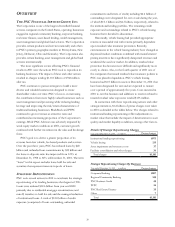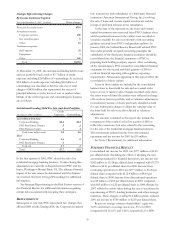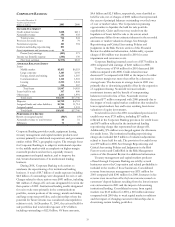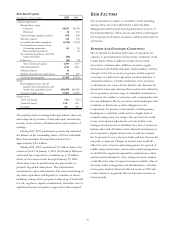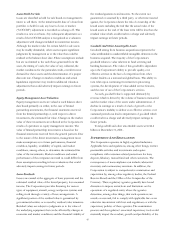PNC Bank 2001 Annual Report Download - page 37
Download and view the complete annual report
Please find page 37 of the 2001 PNC Bank annual report below. You can navigate through the pages in the report by either clicking on the pages listed below, or by using the keyword search tool below to find specific information within the annual report.
35
PNC BUSINESS CREDIT
Year ended December 31
Taxable-equivalent basis
Dollars in millions 2001 2000
INCOME STATEMENT
Net interest income $104 $99
Noninterest income 30 20
Total revenue 134 119
Provision for credit losses 19 12
Noninterest expense 31 30
Institutional lending repositioning 48
Pretax earnings 36 77
Income taxes 14 28
Earnings $22 $49
AVERAGE BALANCE
S
HEET
Loans $2,331 $2,197
Loans held for sale 72 24
Other assets 60 50
Total assets $2,463 $2,271
Deposits $77 $66
Assigned funds and other liabilities 2,223 2,053
Assigned capital 163 152
Total funds $2,463 $2,271
P
ERFORMANCE
R
ATIO
S
Return on assigned capital 13% 32%
Efficiency 30 24
PNC Business Credit provides asset-based lending, capital
markets and treasury management products and services to
middle market customers nationally. PNC Business Credit’s
lending services include loans secured by accounts receivable,
inventory, machinery and equipment, and other collateral,
and its customers include manufacturing, wholesale,
distribution, retailing and service industry companies.
In January 2002, PNC Business Credit acquired a portion
of the U.S. asset-based lending business of NBOC. As a
result of this acquisition, PNC Business Credit established six
new marketing offices and enhanced its presence as one of
the premier asset-based lenders for the middle market
customer segment. At the acquisition date, credit exposure
acquired was approximately $2.6 billion including $1.5 billion
of loan outstandings. None of the loans were nonperforming
at acquisition.
Additionally, PNC Business Credit agreed to service a
portion of NBOC’s remaining U.S. asset-based loan
portfolio (“serviced portfolio”) for a period of eighteen
months. The serviced portfolio consisted of approximately
$670 million of credit exposure including $463 million of
outstandings as of the acquisition date. At closing, $138
million of these outstandings were classified as
nonperforming. The serviced portfolio’s credit exposure and
outstandings are expected to be reduced through managed
liquidation and runoff during the eighteen-month servicing
period. At the end of the servicing term, NBOC has the right
to transfer the then remaining serviced portfolio to PNC
Business Credit. PNC Business Credit established a liability
of $112 million in 2002 as part of the allocation of the
purchase price to reflect this obligation. The amount of this
liability will be assessed quarterly with any changes
recognized in earnings. During the servicing term, NBOC
will be responsible for realized credit losses with respect to
the serviced portfolio to a maximum of $50 million. If the
right to transfer is exercised, the Corporation is responsible
for realized credit losses on the serviced portfolio that may
occur during the eighteen-month period in excess of certain
NBOC specific reserves related to those assets, when
applicable (available only on specified credits), and the $50
million first loss position. PNC Business Credit management
currently expects the amounts indicated above to be
adequate to cover potential losses in connection with the
serviced portfolio.
During 2001, as part of the overall lending repositioning,
a total of $88 million of credit exposure including $78 million
of outstandings was designated for sale. At December 31,
2001, $40 million of credit exposure including $30 million of
outstandings was classified as held for sale, net of charges of
$48 million that represented the excess of principal balances
outstanding over the lower of cost or market values. See
Strategic Repositioning and Critical Accounting Policies and
Judgments in the Risk Factors section of this Financial
Review for additional information.
PNC Business Credit earnings were $22 million in 2001
compared with $49 million in 2000.
Revenue was $134 million for 2001, a $15 million or 13%
increase compared with 2000 primarily due to higher net
interest income, as a result of loan growth, and higher
noninterest income. The increase in noninterest income
primarily resulted from gains on sales of equity interests
received as compensation in conjunction with lending
relationships. Such gains, if any, are recognized infrequently
and may produce variability in revenues from period to
period.
Total credit costs in the 2001 consolidated provision for
credit losses were $29 million, including $19 million reflected
in the PNC Business Credit provision for credit losses and
$10 million reflected in the institutional lending repositioning
charge that represented net charge-offs. The institutional
lending repositioning charge also included $38 million of
valuation adjustments related to loans held for sale. The
provision for credit losses was $12 million in 2000. PNC
Business Credit loans are secured loans to borrowers, many
with a weaker credit risk rating. As a result, these loans
exhibit a higher risk of default. PNC Business Credit
attempts to mitigate this risk through higher interest rates,
direct control of cash flows, and collateral. The impact of
these loans on the provision for credit losses and the level of
nonperforming assets may be even more pronounced during
periods of economic downturn. See Critical Accounting
Policies and Judgments in the Risk Factors section and
Credit Risk in the Risk Management section of this Financial
Review for additional information.





